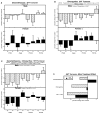Prenatal dexamethasone, as used in preterm labor, worsens the impact of postnatal chlorpyrifos exposure on serotonergic pathways
- PMID: 24280657
- PMCID: PMC3891922
- DOI: 10.1016/j.brainresbull.2013.10.014
Prenatal dexamethasone, as used in preterm labor, worsens the impact of postnatal chlorpyrifos exposure on serotonergic pathways
Abstract
This study explores how glucocorticoids sensitize the developing brain to the organophosphate pesticide, chlorpyrifos. Pregnant rats received a standard therapeutic dose (0.2mg/kg) of dexamethasone on gestational days 17-19; pups were given subtoxic doses of chlorpyrifos on postnatal days 1-4 (1mg/kg, <10% cholinesterase inhibition). We evaluated serotonin (5HT) synaptic function from postnatal day 30 to day 150, assessing the expression of 5HT receptors and the 5HT transporter, along with 5HT turnover (index of presynaptic impulse activity) in brain regions encompassing all the 5HT projections and cell bodies. These parameters are known targets for neurodevelopmental effects of dexamethasone and chlorpyrifos individually. In males, chlorpyrifos evoked overall elevations in the expression of 5HT synaptic proteins, with a progressive increase from adolescence to adulthood; this effect was attenuated by prenatal dexamethasone treatment. The chlorpyrifos-induced upregulation was preceded by deficits in 5HT turnover, indicating that the receptor upregulation was an adaptive response to deficient presynaptic activity. Turnover deficiencies were magnified by dexamethasone pretreatment, worsening the functional impairment caused by chlorpyrifos. In females, chlorpyrifos-induced receptor changes reflected relative sparing of adverse effects compared to males. Nevertheless, prenatal dexamethasone still worsened the 5HT turnover deficits and reduced 5HT receptor expression in females, demonstrating the same adverse interaction. Glucocorticoids are used in 10% of U.S. pregnancies, and are also elevated in maternal stress; accordingly, our results indicate that this group represents a large subpopulation that may have heightened vulnerability to developmental neurotoxicants such as the organophosphates.
Keywords: 5-hydroxytryptamine, serotonin; 5HT; ANOVA; Chlorpyrifos; Dexamethasone; GD; Glucocorticoids; Organophosphate pesticides; PN; Preterm delivery; Serotonin; analysis of variance; gestational day; postnatal day.
Copyright © 2013 Elsevier Inc. All rights reserved.
Figures





Similar articles
-
Prenatal dexamethasone augments the sex-selective developmental neurotoxicity of chlorpyrifos: implications for vulnerability after pharmacotherapy for preterm labor.Neurotoxicol Teratol. 2013 May-Jun;37:1-12. doi: 10.1016/j.ntt.2013.02.002. Epub 2013 Feb 14. Neurotoxicol Teratol. 2013. PMID: 23416428 Free PMC article.
-
Critical prenatal and postnatal periods for persistent effects of dexamethasone on serotonergic and dopaminergic systems.Neuropsychopharmacology. 2006 May;31(5):904-11. doi: 10.1038/sj.npp.1300892. Neuropsychopharmacology. 2006. PMID: 16160705
-
Mimicking maternal smoking and pharmacotherapy of preterm labor: interactions of fetal nicotine and dexamethasone on serotonin and dopamine synaptic function in adolescence and adulthood.Brain Res Bull. 2010 Apr 29;82(1-2):124-34. doi: 10.1016/j.brainresbull.2010.02.015. Epub 2010 Mar 6. Brain Res Bull. 2010. PMID: 20211707
-
Does early-life exposure to organophosphate insecticides lead to prediabetes and obesity?Reprod Toxicol. 2011 Apr;31(3):297-301. doi: 10.1016/j.reprotox.2010.07.012. Epub 2010 Sep 17. Reprod Toxicol. 2011. PMID: 20850519 Free PMC article. Review.
-
Cardiovascular serotonergic system: Evolution, receptors, transporter, and function.J Exp Zool A Ecol Integr Physiol. 2022 Feb;337(2):115-127. doi: 10.1002/jez.2554. Epub 2021 Oct 18. J Exp Zool A Ecol Integr Physiol. 2022. PMID: 34662506 Review.
Cited by
-
Sex-Specific Effects of Combined Exposure to Chemical and Non-chemical Stressors on Neuroendocrine Development: a Review of Recent Findings and Putative Mechanisms.Curr Environ Health Rep. 2017 Dec;4(4):415-425. doi: 10.1007/s40572-017-0165-9. Curr Environ Health Rep. 2017. PMID: 29027649 Free PMC article. Review.
-
Prenatal nicotine changes the response to postnatal chlorpyrifos: Interactions targeting serotonergic synaptic function and cognition.Brain Res Bull. 2015 Feb;111:84-96. doi: 10.1016/j.brainresbull.2015.01.003. Epub 2015 Jan 12. Brain Res Bull. 2015. PMID: 25592617 Free PMC article.
-
Effects of maternal chlorpyrifos diet on social investigation and brain neuroendocrine markers in the offspring - a mouse study.Environ Health. 2015 Apr 2;14:32. doi: 10.1186/s12940-015-0019-6. Environ Health. 2015. PMID: 25889763 Free PMC article.
-
Prenatal and postnatal drug exposure: focus on persistent central effects.Neural Regen Res. 2023 Aug;18(8):1697-1702. doi: 10.4103/1673-5374.363190. Neural Regen Res. 2023. PMID: 36751782 Free PMC article. Review.
-
Prenatal nicotine alters the developmental neurotoxicity of postnatal chlorpyrifos directed toward cholinergic systems: better, worse, or just "different?".Brain Res Bull. 2015 Jan;110:54-67. doi: 10.1016/j.brainresbull.2014.12.003. Epub 2014 Dec 12. Brain Res Bull. 2015. PMID: 25510202 Free PMC article.
References
-
- Aldridge JE, Seidler FJ, Slotkin TA. Developmental exposure to chlorpyrifos elicits sex-selective alterations of serotonergic synaptic function in adulthood: critical periods and regional selectivity for effects on the serotonin transporter, receptor subtypes, and cell signaling. Environ Health Perspect. 2004;112:148–155. - PMC - PubMed
-
- Arango V, Underwood MD, Boldrini M, Tamir H, Kassir SA, Hsiung S, Chen JJ, Mann JJ. Serotonin-1A receptors, serotonin transporter binding and serotonin transporter mRNA expression in the brainstem of depressed suicide victims. Neuropsychopharmacology. 2001;25:892–903. - PubMed
Publication types
MeSH terms
Substances
Grants and funding
LinkOut - more resources
Full Text Sources
Other Literature Sources
Medical

